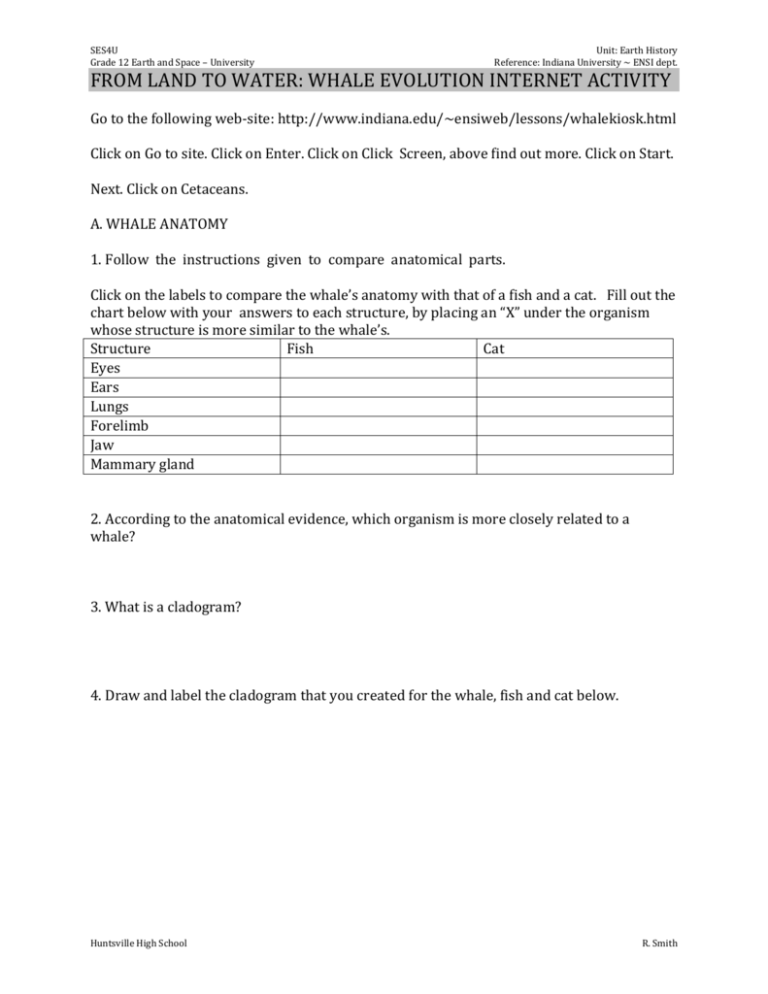FROM LAND TO WATER - Whale Evolution
advertisement

SES4U Grade 12 Earth and Space – University Unit: Earth History Reference: Indiana University ~ ENSI dept. FROM LAND TO WATER: WHALE EVOLUTION INTERNET ACTIVITY Go to the following web-site: http://www.indiana.edu/~ensiweb/lessons/whalekiosk.html Click on Go to site. Click on Enter. Click on Click Screen, above find out more. Click on Start. Next. Click on Cetaceans. A. WHALE ANATOMY 1. Follow the instructions given to compare anatomical parts. Click on the labels to compare the whale’s anatomy with that of a fish and a cat. Fill out the chart below with your answers to each structure, by placing an “X” under the organism whose structure is more similar to the whale’s. Structure Fish Cat Eyes Ears Lungs Forelimb Jaw Mammary gland 2. According to the anatomical evidence, which organism is more closely related to a whale? 3. What is a cladogram? 4. Draw and label the cladogram that you created for the whale, fish and cat below. Huntsville High School R. Smith SES4U Grade 12 Earth and Space – University Unit: Earth History Reference: Indiana University ~ ENSI dept. 5. What is the relationship between whales and cats? B. FOSSIL RECORD 1. What is a fossil? 2. What are the most likely parts to become fossilized? 3. What are trace fossils? List some examples. 4. What is a coprolite? 5. What fossilized anatomical structure can be useful to anatomists? 6. Compare the fossil teeth of whales to the other organisms on the website. What sort of organism has fossil teeth most similar to whale teeth? 7. What are some modern day ungulates? 8. To what group did the other skull belong? 9. Which are more closely related to whales…seals or horses? Huntsville High School R. Smith SES4U Grade 12 Earth and Space – University Unit: Earth History Reference: Indiana University ~ ENSI dept. 10. What other organisms belong in the Order Carnivora? 11. Check out the anklebones. List some examples of modern day Artiodactyls. 12. Which anklebone looks more similar to the fossil whalebone? 13. What does this mean for whale’s closest relatives? 14. Before we look at molecular evidence, check out more in the fossil record. What environmental shift was responsible for the process of natural selection that led to whales? 15. What four parts of the whale have changed over time? 16. Click on the whale forelimb (arm). What is the earliest whale that investigators have found? What does it look like? 17. What were the forelimbs good for in the earliest whale? 18. Compare it to a human arm. How is your arm different from this whale’s arm? 19. Which early whale could walk on land and swim in the water? What does it look like? How do its forelimbs compare to the whale’s arm? Huntsville High School R. Smith SES4U Grade 12 Earth and Space – University Unit: Earth History Reference: Indiana University ~ ENSI dept. 20. What was the first fully aquatic whale? How does its arm compare to Ambulocetus and a modern whale? 21. How are modern whale’s arm bones different? C. THE MOLECULAR PICTURE 1. When finished, click the whale in the bottom left hand corner and return to “Molecules Home”. Which molecules help to show how animals are related? 2. What are chromosomes made of? What is DNA made of? 3. What are the four flavors of nucleotide base pairs? What do they stand for? How do they pair together? What do they do? 4. Compare the patterns of a nucleotide sequence between a whale, a horse, a cow and a seal. Complete the chart: Number of Number of Number of differences: Horse differences: Cow differences: Seal Sequence #1 Sequence #2 Sequence #3 Sequence #4 Sequence #5 Sequence #6 Sequence #7 Sequence #8 Total number of matches 5. Draw your cladogram of the whale, horse, cow and seal below. 6. To which group does the molecular evidence suggest is most closely related to whales? Huntsville High School R. Smith
![Blue and fin whale populations [MM 2.4.1] Ecologists use the](http://s3.studylib.net/store/data/008646945_1-b8cb28bdd3491236d14c964cfafa113a-300x300.png)




